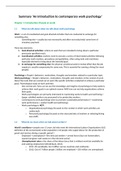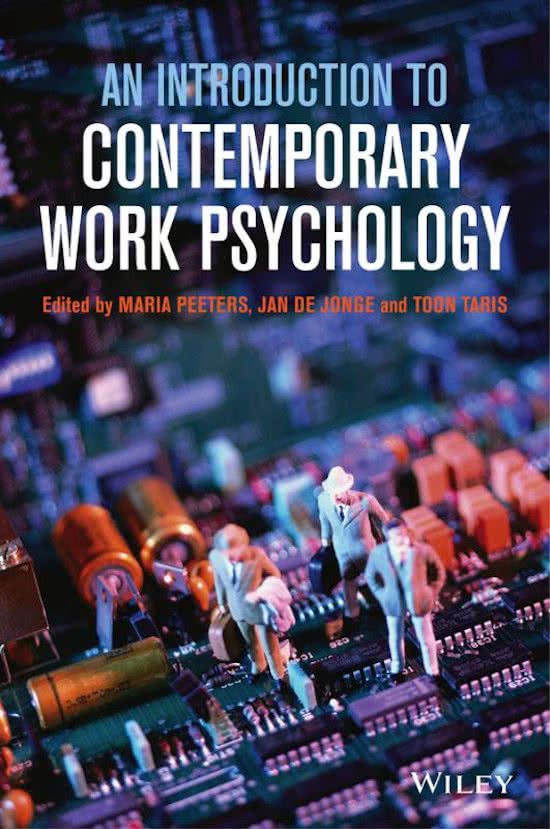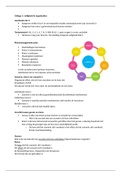Summary ‘An introduction to contemporary work psychology’
Chapter 1: Introduction (People at work)
1.1 What we talk about when we talk about work psychology
Work = a set of coordinated and goal-directed activities that are conducted in exchange for
something else.
- Something else = usually but not necessarily and often not exclusively) some form of
monetary payment.
Three key elements:
1. Goal-directed activities: actions at work that are intended to bring about a particular
previously specified result.
2. Coordinated activities: workers need to execute a series of interrelated activities following
particular work routines, procedures and guidelines, often using tools and machinery
especially devised to bring about the intended goal.
3. In exchange for something else: the physical, emotional and/or mental effort that the job
requires is usually compensated in some way. This is essential for earning a living (for most
people).
Psychology = People’s behaviors, motivations, thoughts and emotions related to a particular topic.
Work psychology = People’s behaviors, motivations, thoughts and emotions in the context of work.
About the tasks that are carried out at work (the specific activities conducted to achieve a particular
goal). Psychological study of work activities.
- One central aim: how can we use the knowledge and insights of psychology to help workers
achieve their work goals in an optimal manner AND how can we help organizations achieve
their goals.
- Work psychologists are primarily interested in maximizing workers health and well-being >
happy, satisfied workers are presumed to be productive workers.
- Contemporary work psychology aims to promote sustainable performance (= maximizing
work performance + worker health and well-being).
- Work psychology is NOT:
o Organizational psychology (focused on the context in which work activities are
conducted);
o Personnel psychology (focused on the characteristics of workers or selecting/hiring
new staff).
1.2 What do we mean when we talk about workers?
World’s workforce = people over 15 years old who meet the International Labour Organizations (ILO)
definition of the economically active population (‘all people who supply labour for the production of
goods and services during a specific period’).
- Employed + unemployed + first time job seekers + armed forces (but not homemakers,
unpaid caregivers and workers in the informal sector)
- Unemployment rates = the share of the labour force that is without work but available for
and seeking employment (World Bank, 2013).
o 2011: 6% worldwide, but it differs across countries and continents.
o 2012: Out of 7 billion people 3 billion are employed + 205 million are unemployed.
,Three different work sectors:
1. Agriculture (including forestry, hunting, fishing);
2. Industry (including manufacturing, mining, construction);
3. Services (including transportation, communication, public utilities, trade, finance,
administration, private household services + many more)
Agriculture is declining, industry is declining a bit, while services are growing (mainly in Western
developed countries).
Contemporary work psychology doesn’t focus on all employed workers around the world. Research is
narrow, and mainly conducted in Western-oriented countries. Developing countries are largely
neglected.
- Mainly focus on white collar (suit-and-tie workers who work at a desk and, stereotypically,
eschew (zich onthouden van) physical labour), professional and middle to highly educated
employees working in large organizations.
o Historically more blue-collar workers in poor working conditions.
o Change to white collar nowadays > easier to gain access to, higher response rates,
don’t have to translate instruments.
1.3 The meaning of working
“Work is hell – but it beats unemployment” (Matt Groening, 1987)
Workers do not always (normally/frequently) enjoy their work, and that is portraited in popular
culture (movies, music, books, etc.).
- However, research found that work is not just for money (to have enough money to live), but
serves many other functions:
o Marie Jahoda’s Relative Deprivation Model (1982); apart from providing income,
having employment proved 5 classes of social benefits:
Time structure
Opportunities for social contact
Sharing of a common purpose
Social identity or status
Regular activity
- Quality of life is higher for employed people than for unemployed people (regarding (mental
& physical) health and life satisfaction)
o Lack of health increases the chances of unemployment, and unemployment
contributes to the emergence of health problems.
- Mankind tries and has been trying to make working life easier, by introducing new
technologies, or the rise of information and communication technology (ICT).
o Driver of these innovations was the desire to spend less time on work
,1.4 The roots of work psychology
Hippocratic collection (500-300 BC); provided doctors with detailed guidelines on how particular
types of complaints were to be treated.
De Re Militari (On military matters) (Vegetius, Roman writer)(390 AD); about the organization,
equipment and drill fo the Roman legions > the strategies to be followed, the maintenance of supply
lines and logistics, and leadership.
o Also described that psychological processes could affect the execution of soldiers’
tasks.
De Re Metallica (On metal matters) (Agricola/George Bauer)(1500’s); influential book on the art and
science of mining. Agricola (town physician) not only discussed the technical details, but paid
attention to miners and their typical diseases.
- Stated that miners should have a 5-day workweek, with three shifts of 8 hours (no two shifts
behind each other).
- Work of Agricola was followed by Bernardino Ramazzini (De Morbis Articifium Diatriba)
(1700), that described typical diseases encountered by workers in 52 occupations.
- These works are the starting point of occupational medicine)
Industrial revolution (1750-1850); marked a transition towards new manufacturing processes > more
mechanized (using novel technology) and industrialized (more mass production).
- Reformed the economy into that of industrial capitalism.
- Large industrial plants were built > ways to transport materials and goods were build >
leading to increased urbanization.
- Working conditions were harsh, working days were long and pay was low.
- Tasks had a high level of division of labour, and were usually simple, repetitive and boring,
requiring few skills.
o Issues in this era: how can workers be motivated to work hard and how can they be
made more productive.
, Applied psychology/psychotechnics (Hugo Münsterberg + William Stern); attempted to apply
psychological insights, obtained through empirical research and rigid measurement, to the work
environment.
- Both worked in vocational psychology = the branch of personnel psychology that focuses on
the link between workers’ characteristics and job requirements, assuming that worker well-
being and productivity are optimal when there is a good match between the job and the
worker.
Scientific Management/Taylorism (Frederick Taylor)(1911-1950); belief that productivity could be
optimized by concentrating on the task, by simplifying it to such a degree that any worker would be
able to do it.
- Taylor had 2 basis assumptions: workers were lazy and stupid.
o Stupidity improvements:
Simplifying tasks using scientific methods; tasks were broken down into
smaller and simpler subtasks.
Examining the best way to conduct these tasks ; for each task, there was one
best way to perform it, and any other approach was suboptimal and
discouraged.
One best way: used the most successful employee or used time and
motion studies (Gilbreths, 1910-1920)
Training workers in ‘the one best way’; so that even relatively unskilled
(‘dumb’) workers could be trained to perform the task fast and efficiently,
resulting in higher productivity.
Separating planning of tasks from their execution ; workers should not think
about how they should conduct the tasks, this should be decided for them by
their supervisors.
Selecting workers for particular tasks; some workers were too intelligent for
the simpler tasks, so not all workers were equally well-suited for all tasks
o Laziness improvements: introducing high levels of control and supervision + pay for
performance systems (you work harder, you get paid more, you work slower, you get
fired).
- Scientific management became quickly popular among management of large factories, but
not among workers and worker unions. Taylorism resulted in repetitive, boring and physically
demanding jobs. After the best days for Taylorism (till 1930), companies began to see the
negative effects and the strengthening of the position of the labour unions and recurring
strikes.
Human Relations Movement
- Fit the job to the worker, paying special attention to the human side of working.
- Originated from Hawthorne Experiments (Elton Mayo, Fritz Roethlisberger, 1924-1933,
Hawthorne plant of Western Electric (AT&T)
o Company had become aware of the drawbacks of Scientific Management (1920) and
wanted to focus on the well-being of the workers, to promote worker commitment
and to discourage worker turn-over and unionization.
They introduced pensions, sick pay, stocks purchase plans and there was a
range of educational and recreational programs for it’s employees.
o They were interested in research on worker productivity, motivation and satisfaction,
and undertook a series of behavioral experiments to examine the effects of
contextual factors (light, breaks, wages) on worker productivity.
o Studies provided little to no evidence for the effects, but Mayo and Roethlisberger
were convinced that the intimate setting of the experiments caused the participants







